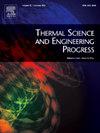Heat transfer mechanism of downward flame spread over convex and inclined flat surfaces
IF 5.1
3区 工程技术
Q2 ENERGY & FUELS
引用次数: 0
Abstract
Convex structures are common in buildings. However, the underlying mechanism governing downward flame spread on convex surfaces remains inadequately understood. In this study, 65 kinds of convex and flat surfaces were designed by varying curvature (denoted by K, 0–2.00 m−1), inclination angle (θ, 0–45°), and material widths (W, 2.5–12.5 cm). The downward flame spread behaviors on convex surfaces was then experimentally compared with that on flat surfaces. It is found that as K and θ increase, the average path flame spread rate (APFSR) decreases firstly (Stage I) and then is basically unchanged (Stage II). For convex and inclined flat surfaces, the critical conditions for the change from Stage I to II are K = 1.00 m−1 and θ = 30° respectively. Moreover, APFSR on convex surfaces is higher than that on flat surfaces. A mathematical correlation is proposed to quantify the relationship between the APFSRs of convex and flat surfaces. In addition, by introducing deRis and infinite-width flame spread models, the time-varying flame spread rate of the convex surface is further discussed to analyze the heat transfer mechanisms. For K < 1.00 m−1, radiant heat transfer has an important contribution during the flame spread process. However, for K > 1.41 m−1, the flame spread process is consistent with deRis model, indicating gas-phase conduction-dominated mechanism. This study can provide a theoretical basis for fire safety design in complex curved structures.
向下火焰在凹凸和倾斜平面上传播的传热机理
凸结构在建筑物中很常见。然而,控制火焰向下蔓延的潜在机制在凸表面仍然不充分了解。本研究设计了65种不同曲率(K, 0-2.00 m−1)、倾角(θ, 0-45°)和材料宽度(W, 2.5-12.5 cm)的凸面和平面。然后实验比较了火焰在凹凸表面上的向下传播行为与在平面上的向下传播行为。发现随着K和θ的增大,平均路径火焰蔓延速率(APFSR)先减小(阶段1),后基本保持不变(阶段2)。对于凸平面和斜平面,从阶段1过渡到阶段2的临界条件分别为K = 1.00 m−1和θ = 30°。此外,凸表面的APFSR高于平面。提出了一种量化凸面与平面apfsr之间关系的数学关联。此外,通过引入deRis和无限宽火焰传播模型,进一步讨论了凸表面火焰传播速率的时变问题,分析了传热机理。对于K <;1.00 m−1时,辐射传热在火焰蔓延过程中有重要贡献。然而,对于K >;1.41 m−1时,火焰蔓延过程符合deRis模型,表明气相传导为主。该研究可为复杂弯曲结构的防火安全设计提供理论依据。
本文章由计算机程序翻译,如有差异,请以英文原文为准。
求助全文
约1分钟内获得全文
求助全文
来源期刊

Thermal Science and Engineering Progress
Chemical Engineering-Fluid Flow and Transfer Processes
CiteScore
7.20
自引率
10.40%
发文量
327
审稿时长
41 days
期刊介绍:
Thermal Science and Engineering Progress (TSEP) publishes original, high-quality research articles that span activities ranging from fundamental scientific research and discussion of the more controversial thermodynamic theories, to developments in thermal engineering that are in many instances examples of the way scientists and engineers are addressing the challenges facing a growing population – smart cities and global warming – maximising thermodynamic efficiencies and minimising all heat losses. It is intended that these will be of current relevance and interest to industry, academia and other practitioners. It is evident that many specialised journals in thermal and, to some extent, in fluid disciplines tend to focus on topics that can be classified as fundamental in nature, or are ‘applied’ and near-market. Thermal Science and Engineering Progress will bridge the gap between these two areas, allowing authors to make an easy choice, should they or a journal editor feel that their papers are ‘out of scope’ when considering other journals. The range of topics covered by Thermal Science and Engineering Progress addresses the rapid rate of development being made in thermal transfer processes as they affect traditional fields, and important growth in the topical research areas of aerospace, thermal biological and medical systems, electronics and nano-technologies, renewable energy systems, food production (including agriculture), and the need to minimise man-made thermal impacts on climate change. Review articles on appropriate topics for TSEP are encouraged, although until TSEP is fully established, these will be limited in number. Before submitting such articles, please contact one of the Editors, or a member of the Editorial Advisory Board with an outline of your proposal and your expertise in the area of your review.
 求助内容:
求助内容: 应助结果提醒方式:
应助结果提醒方式:


